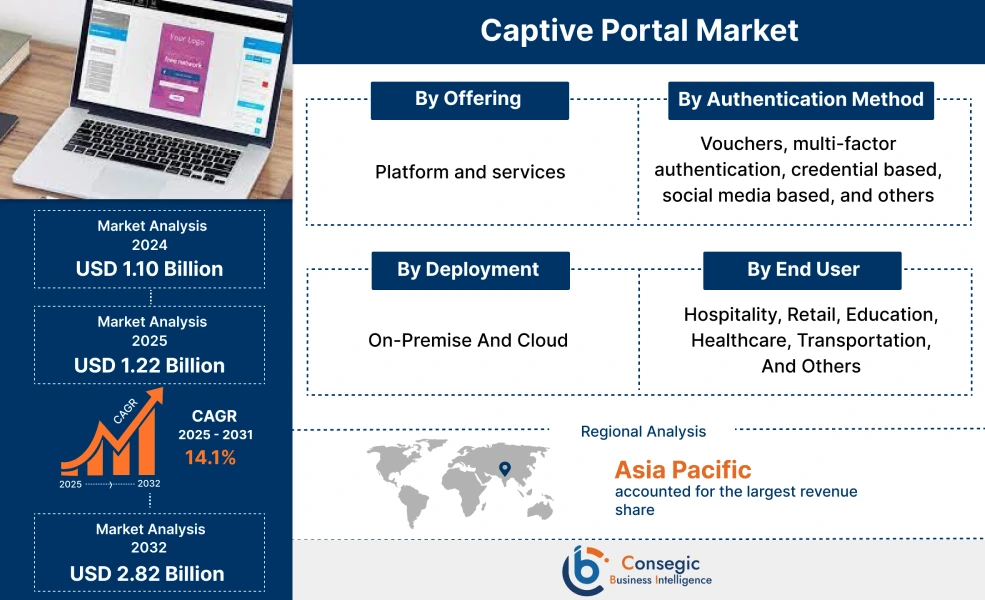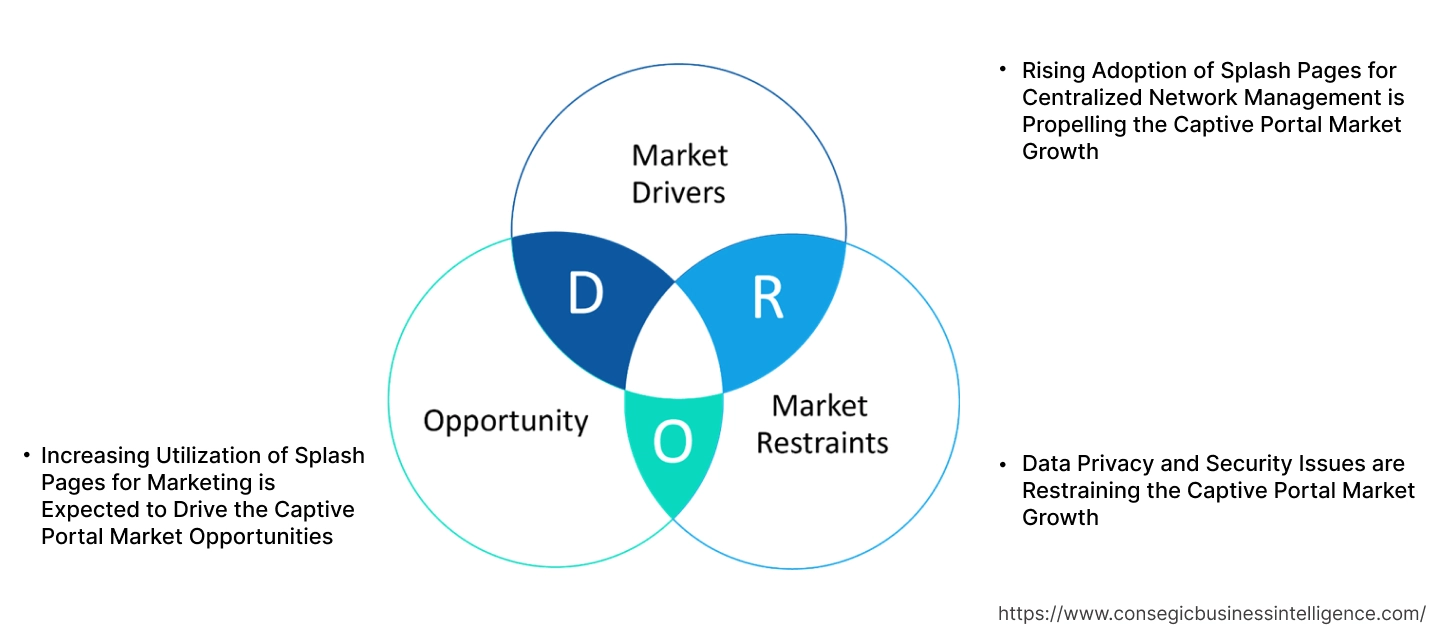Captive Portal Market Size:
Captive Portal Market size is estimated to reach over USD 2.82 Billion by 2032 from a value of USD 1.10 Billion in 2024 and is projected to grow by USD 1.22 Billion in 2025, growing at a CAGR of 14.1% from 2025 to 2032.
Captive Portal Market Scope & Overview:
A captive portal or splash page is a webpage that users get directed to when they attempt to access a Wi-Fi network. The portal features a customized login page that the users must address before they are able to connect to a network. Further, the portals allow business the ability to control and monitor the users who can access the network, resulting in enhanced security. Moreover, the portals can help with marketing by allowing the business to display new product offerings or services and brand logos on the webpage which is driving the market.
How is AI Impacting the Captive Portal Market?
AI is reshaping the captive portal market by transforming the user experience and improving network management. Machine learning algorithms analyze user behavior and demographics from login data to deliver highly personalized content, promotions, and advertisements. This turns a simple Wi-Fi login page into a powerful marketing tool for businesses. AI also enhances security by using predictive analytics to detect and prevent suspicious activity or unauthorized access in real-time, strengthening network defenses against threats. Furthermore, AI-powered automation streamlines the management of large-scale captive portals, optimizing performance and reducing the manual effort required for configuration and troubleshooting, which improves operational efficiency and user satisfaction.
Captive Portal Market Dynamics - (DRO) :
Key Drivers:
Rising Adoption of Splash Pages for Centralized Network Management is Propelling the Captive Portal Market Growth
Splash pages have experienced a rising adoption in open wireless networks to allow secure access to the networks. Additionally, the administrators of the networks can use the splash pages to ensure only authenticated users access the network by using multi-factor authentication. Moreover, the administrators have started utilizing the portals to gain valuable insights into user activity by analyzing bandwidth usage and session length which has driven the market.
- For instance, MAS Computer Development offers WifiGem, a portal that features real-time monitoring on a dashboard. The portal can be used to monitor user logs and analyze network traffic.
Hence, the rising adoption of splash pages for centralized network management by analyzing user bandwidth usage and session length is driving the captive portal market size.
Key Restraints:
Data Privacy and Security Issues are Restraining the Captive Portal Market Growth
Splash pages collect user data including name, email, and phone number through social media logins and registration forms. Further, the collection of this data may pose several risks to the business including compliance with data protection laws and audit compliance. Moreover, businesses use the splash pages to collect the data and share it with third parties, which can act as a restraint to the market growth as the data may get exposed to various risks including data breaches or misuse.
Thus, data privacy and security issues due to usage collection of user data act as a restraint to the captive portal market expansion.
Future Opportunities :
Increasing Utilization of Splash Pages for Marketing is Expected to Drive the Captive Portal Market Opportunities
Splash pages can be customized to feature logos, cover images, and custom links which can enhance branding. Moreover, the portals can feature welcome messages based on different locations offering a personalized experience to the user. Additionally, many providers offer localized content by integrating different languages and automatic translation features which is driving the overall market.
- For instance, TP-Link offers Omada networking platform with captive portal features for customized branding and social media marketing. The rise in the number of splash page offerings for marketing is expected to boost the overall market.
Thus, the increasing utilization of splash pages for marketing by integrating welcome messages and automatic translation is projected to drive the captive portal market opportunities during the forecast period.
Captive Portal Market Segmental Analysis :
By Offering:
Based on the offering, the market is segmented into platform and services.
Trends in the offering:
- Increasing adoption of platform that features brand videos is driving the captive portal market share.
- Rising utilization of platform to influence purchasing decisions is driving the captive portal market trends.
Platform accounted for the largest revenue share in the year 2024 and is anticipated to register the fastest CAGR during the forecast period.
- In the splash page market, platform based pages have experienced a rising adoption by education institutes to keep track of the websites the visitors visit, which has resulted in the captive portal market expansion.
- Additionally, platform based software is increasingly used as a marketing tool by shopping malls and cafes to analyse consumer behaviour which is driving the global captive portal market.
- Moreover, the increasing number of platform offerings by companies that capture key contact details including name, email, and phone number is driving the captive portal market size.
- For instance, Purple offers captive portal that can utilized to analyze network traffic, customize access, and capture consumer data. The rising number of platform offerings for Wi-Fi access management is expected to drive the market.
- Thus, the increasing utilization of splash pages to track user activity and analyse consumer behaviour is driving the overall market.
By Authentication Method:
Based on the authentication method, the market is segmented into vouchers, multi-factor authentication, credential based, social media based, and others.
Trends in the authentication method:
- Increasing adoption of multi-factor authentication to protect against phishing attacks is driving the captive portal market trends.
- There has been a rising utilization of social media based authentication for a fast login experience which is driving the captive portal market demand.
Social media based accounted for the largest revenue share of 32.49% in the year 2024.
- In social media based authentication, users utilize their social media accounts to sign into the Wi-Fi.
- Moreover, rising adoption by businesses to enable social media sign in options to collect social media profile data and utilize the data for targeted marketing is driving the overall market.
- For instance, Juniper offers social login feature on its captive portal to allow users to connect to the network using Google and Facebook accounts.
- Therefore, the rising utilization of social media based authentication due to demand for targeted marketing is driving the market.
Multi-factor authentication is anticipated to register the fastest CAGR during the forecast period.
- Multi-factor authentication requires the users to provide two or more verification factors to gain access to the Wi-Fi.
- Further, the rising utilization of multi-factor authentication due to improved access control is driving the captive portal market demand.
- Moreover, multi-factor authentication has experienced a rising adoption to enhance user confidence by adding a layer of security in the portals.
- Thus, as per the analysis, the rising adoption of multi-factor authentication due to improved access control is driving the market.
By Deployment:
Based on the deployment, the market is segmented into on-premise and cloud.
Trends in the deployment:
- Increasing adoption of cloud due to easy onboarding of devices which is driving the market trends.
- Rising adoption of cloud due to easy deployment and scalability is driving the market growth.
Cloud accounted for the largest revenue share in the year 2024 and is anticipated to register the fastest CAGR during the forecast period.
- Cloud splash pages have experienced a rising adoption due to enhanced ad promotions and remote troubleshooting.
- Moreover, there has been a rising utilization of splash pages that feature customized design to enhance user engagement which is driving the growth of the market.
- For instance, CLOUDI-FI offers cloud splash page that features various authentication mechanism including social network login, declarative email, and SMS.
- According to the captive portal market analysis, the rising trend in the cloud splash pages due to ad promotions and remote troubleshooting is propelling the captive portal industry during the forecast period.
By End Use:
Based on the end user, the market is segmented into hospitality, retail, education, healthcare, transportation, and others.
Trends in the end user
- Increasing adoption of the splash pages in hospitality due to integration with CRM systems is driving the market.
- There has been a rising adoption of splash pages in transportation that feature bandwidth management for users which is driving the market.
Hospitality accounted for the largest revenue share in the year 2024.
- In hospitality, splash pages are being used by hotels to collect guest data and understand guest preferences using the data.
- Further, there has been a rising utilization of splash pages by restaurants to generate high quality leads which is driving the market, as per the analysis.
- Moreover, cafes have started using custom designed templates that feature their logos on the splash pages which has driven the market.
- For instance, Wiacom offers splash page for hotels, hostels, and resorts to enhance guest experience through customized branding and custom templates.
- Therefore, the rising adoption of splash pages in hospitality due to collection of guest data and generation of leads is driving the market.
Transportation is anticipated to register the fastest CAGR during the forecast period.
- Transportation has experienced a rising adoption of splash pages due to data limits feature that allow user-specific consumption limits.
- Moreover, the splash pages are increasingly utilized in airports to showcase promotions and announcements which is driving the market.
- For instance, AVSystem offers Linkyfi splash page for airports to enhance brand identity by integrating high quality graphic and photos.
- Thus, the rising utilization of the splash pages in transportation to specific data consumption limits and showcase announcements is driving the market.
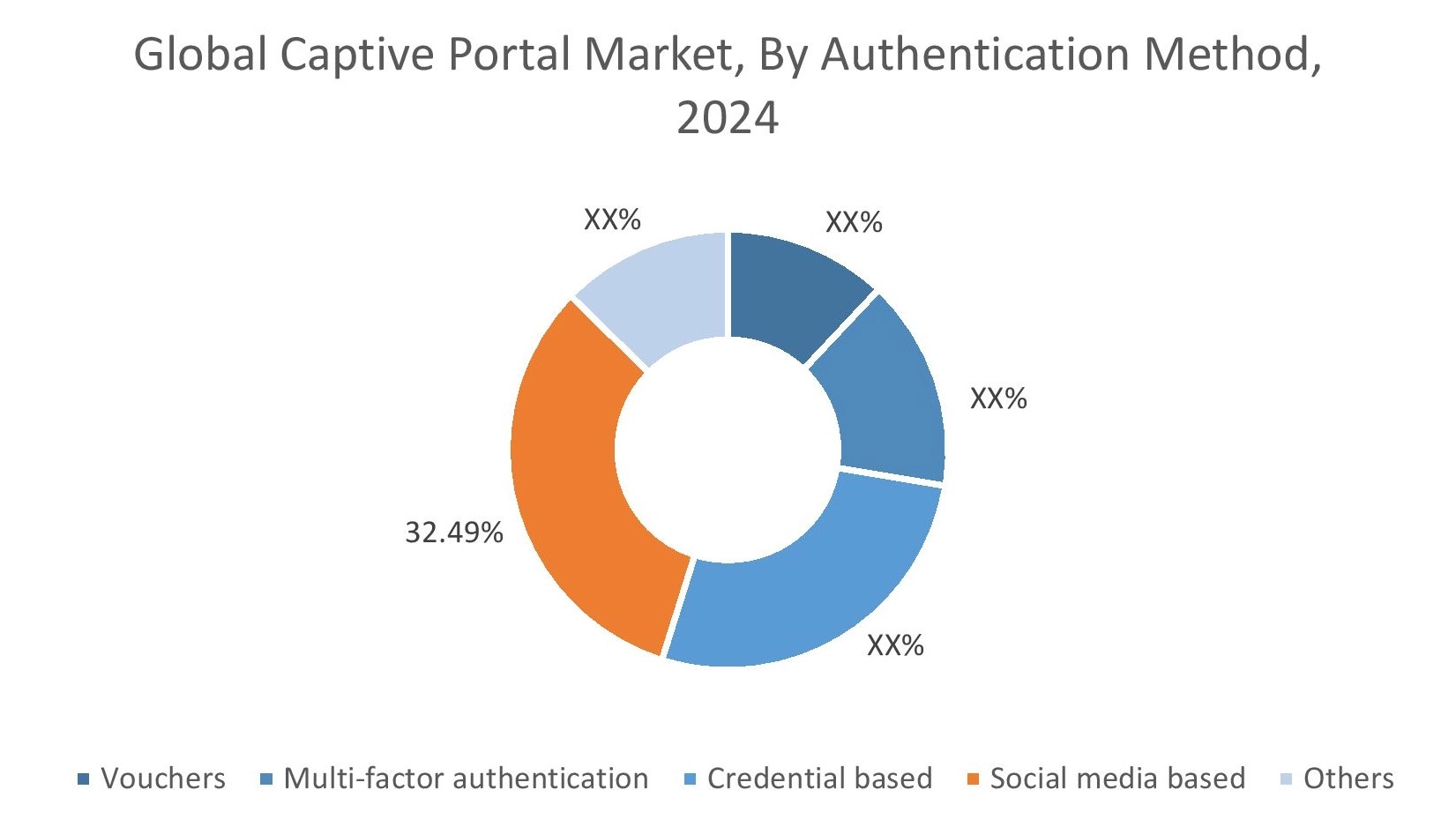
Regional Analysis:
The regions covered are North America, Europe, Asia Pacific, the Middle East and Africa, and Latin America.
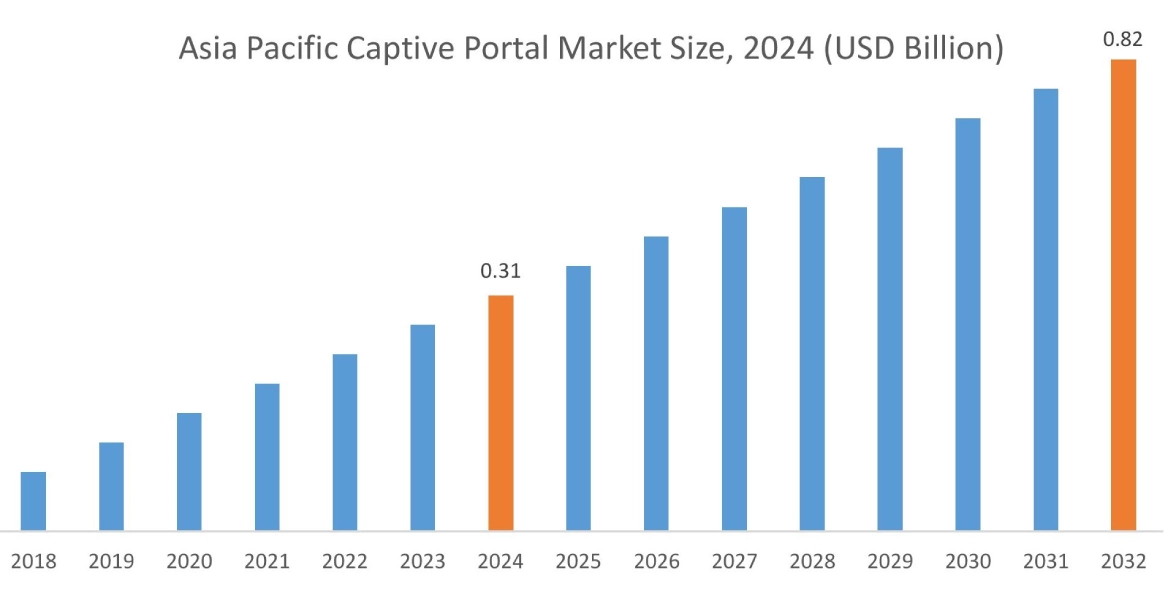
Asia Pacific region was valued at 0.31 Billion in 2024. Moreover, it is projected to grow by 0.34 Billion in 2025 and reach over 0.82 Billion by 2032. Out of this, China accounted for the maximum revenue share of 31.90%. As per the captive portal market analysis, the growth in the Asia-Pacific region is primarily driven by the increasing utilization of cloud based portals and increasing investments by airports.
- For instance, Kloudspot offers splash pages for the transportation sector including airports featuring cloud and on-premise deployment. The rise in offerings by companies to deploy splash pages in airports for brand promotions is expected to boost the market.
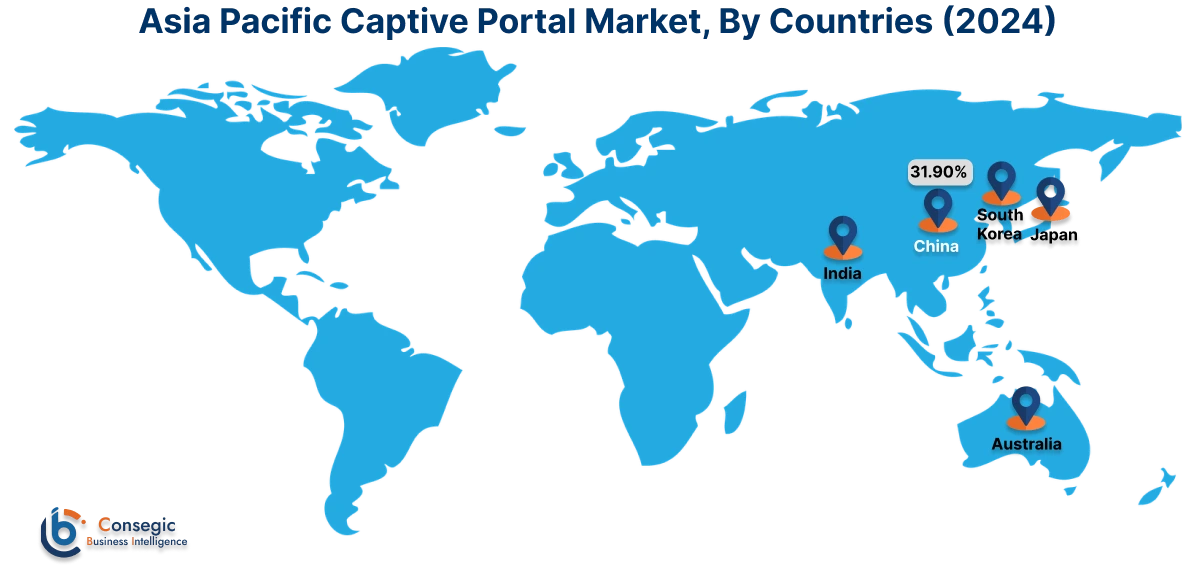
North America is estimated to reach over USD 0.91 Billion by 2032 from a value of USD 0.35 Billion in 2024 and is projected to grow by USD 0.39 Billion in 2025. In North America, the growth of captive portal industry is driven by the increasing adoption of multi-factor authentication methods in the portals. Moreover, increased marketing spending has resulted in the rise of captive portal market share.
- For instance, according to The CMO Survey, digital marketing spending rose from 8.9% in Spring 24 to 11.1% in Fall 24. The increase in marketing spending is expected to boost the market as companies invest in targeted marketing through splash pages.
Additionally, the regional analysis depicts that the rising utilization of cloud is driving the market demand in Europe. Furthermore, as per the market analysis, the market demand in Latin America is expected to grow at a considerable rate due to rising investments by hospitals to improve IT infrastructure. Middle East and African regions are expected to grow at a considerable rate due to factors such as increasing investments in brand building and rising smartphone usage among others.
Top Key Players and Market Share Insights:
The global captive portal market is highly competitive with major players providing solutions to the national and international markets. Key players are adopting several strategies in research and development (R&D), product innovation, and end-user launches to hold a strong position in the captive portal market. Key players in the captive portal industry include-
- Juniper Networks (U.S.)
- Kloudspot Inc. (U.S.)
- Enea (Sweden)
- Fortinet, Inc. (U.S.)
- Cloudi-Fi (France)
- Sophos Limited (U.K.)
- Purple (U.K.)
- Cisco Systems (U.S.)
- Hewlett Packard Enterprise Development (U.S.)
- TP-Link Systems Inc. (U.S.)
Recent Industry Developments :
Merger and Acquisition:
- In January 2024, Hewlett Packard Enterprise (HPE) announced the acquisition of Juniper Networks for about USD 14 billion in an all-cash transaction. HPE aims to double their networking business and expand the company’s total addressable market through the acquisition.
Captive Portal Market Report Insights :
| Report Attributes | Report Details |
| Study Timeline | 2019-2032 |
| Market Size in 2032 | USD 2.82 Billion |
| CAGR (2025-2032) | 14.1% |
| By Offering |
|
| By Authentication Method |
|
| By Deployment |
|
| By End User |
|
| By Region |
|
| Key Players |
|
| North America | U.S. Canada Mexico |
| Europe | U.K. Germany France Spain Italy Russia Benelux Rest of Europe |
| APAC | China South Korea Japan India Australia ASEAN Rest of Asia-Pacific |
| Middle East and Africa | GCC Turkey South Africa Rest of MEA |
| LATAM | Brazil Argentina Chile Rest of LATAM |
| Report Coverage |
|
Key Questions Answered in the Report
How big is the captive portal market? +
The captive portal market was valued at USD 1.10 Billion in 2024 and is projected to grow to USD 2.82 Billion by 2032.
Which is the fastest-growing region in the captive portal market? +
Asia-Pacific region is experiencing the most rapid growth in the captive portal market.
What specific segmentation details are covered in the captive portal market report? +
The captive portal market report includes offering, authentication method, deployment, end user and region.
Who are the major players in the captive portal market? +
The key participants in the captive portal market are Juniper Networks (U.S.), Sophos Limited (U.K.), Purple (U.K.), Cisco Systems (U.S.), Hewlett Packard Enterprise Development (U.S.), TP-Link Systems Inc. (U.S.), Kloudspot Inc. (U.S.), Enea (Sweden), Fortinet, Inc. (U.S.), Cloudi-Fi (France), and Others.
